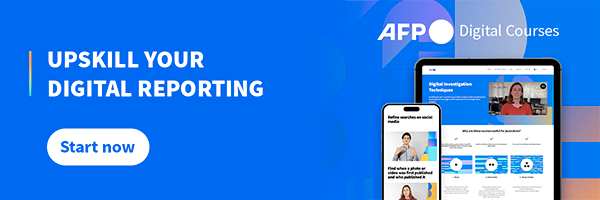
Old US and European space agency photos falsely linked to China's Chang'e-6 Moon mission
- This article is more than one year old.
- Published on May 27, 2024 at 06:15
- 4 min read
- By Tommy WANG, AFP Hong Kong
"Pakistan and France share video images captured with help from China's Chang'e-6," read the simplified Chinese title of a clip posted on Chinese video-sharing platform Bilibili on May 12, 2024.
The Chang'e-6 is a Chinese lunar probe that blasted off on May 3 on an unprecedented 53-day mission to collect samples from the far side of the Moon. Pakistan's The Nation newspaper reported that a satellite jointly developed by Pakistan and China -- the ICUBE-Q -- was also on board (archived link).
The video -- viewed more than 165,000 times -- appears to show satellite footage of valleys and craters on the surface of the Moon.
English-language text overlaid on the video reads: "Pakistan Reached on moon (sic) and some clips from Pakistani Setallite Alhamdulillah (sic). Pakistan Zindabad."
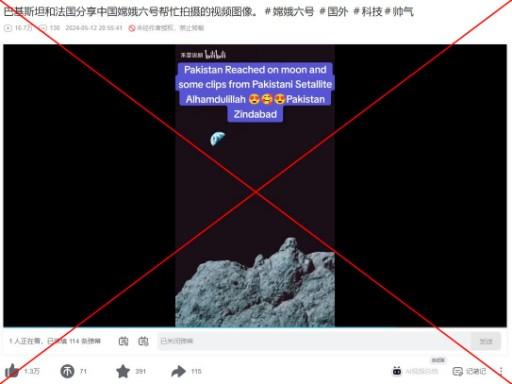
The video circulated after state news agency Xinhua reported that China had delivered data collected during the Chang'e-6 mission, including images taken by the ICUBE-Q satellite, to Pakistan (archived link).
The same video was viewed elsewhere on Chinese video-sharing platforms Bilibili and Xigua Video alongside a similar false claim.
It was also viewed millions of times here on a Pakistan-based TikTok account with the English-language claim about a Pakistani satellite, but no reference to the Chang'e-6 probe.
However, the video does not show clips captured by the ICUBE-Q satellite.
Keyword and reverse image searches on Google found the falsely shared video comprises several old photos of the Moon that were released by the US space agency NASA and the European Space Agency (ESA).
The video zooms and pans across these photos to give the impression of movement.
Apollo programme photos
Three photos in the video were taken during Apollo missions in the late 1960s and early 1970s, and shared on official NASA Flickr accounts here and here (archived links here and here).
The first image used in the falsely shared video has been cropped from a photo taken during NASA's Apollo 10 mission in May 1969 (archived link).
Its description reads: "An Apollo 10 northwestward oblique view of Triesnecker crater, centered near 3.6 degrees east longitude, and 4 degrees north latitude."
Below is a screenshot comparison of the image used in the false video (left) and the NASA photo (right), with the corresponding portion of the photo highlighted by AFP:
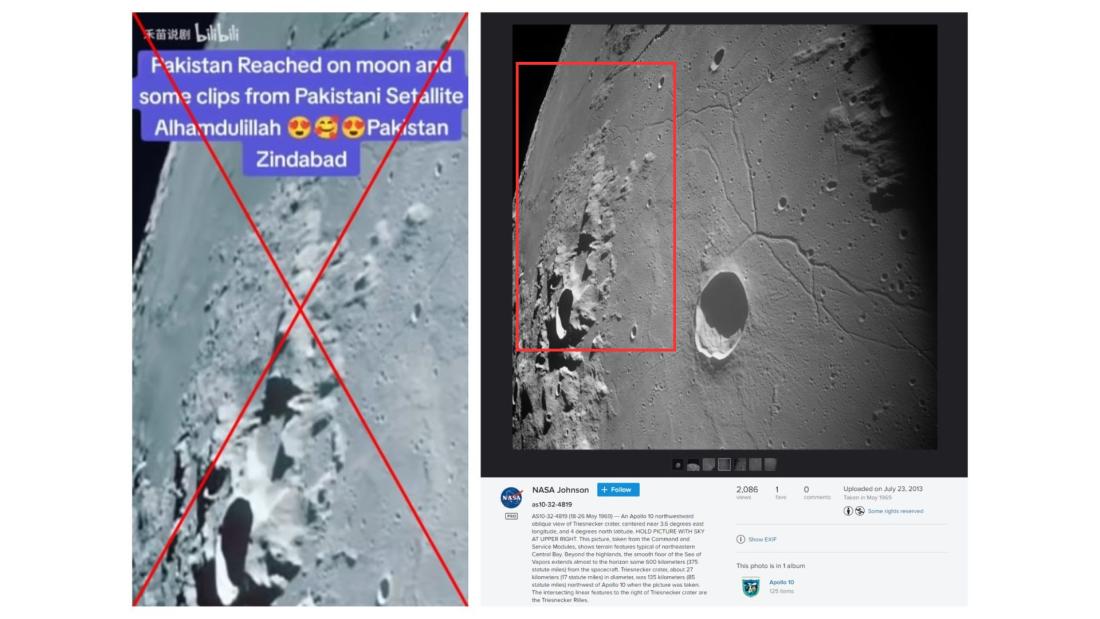
The second image used in the falsely shared video was taken during the Apollo 15 mission, which took place between July and August 1971 (archived link).
According to a caption alongside the same photo on NASA's website, it shows the Aristarchus Plateau, including Vallis Schröteri, and the Aristarchus and Herodotus craters (archived link).
Below is a screenshot comparison of the image used in the false video (left) and the NASA photo (right), with the matching section highlighted by AFP:
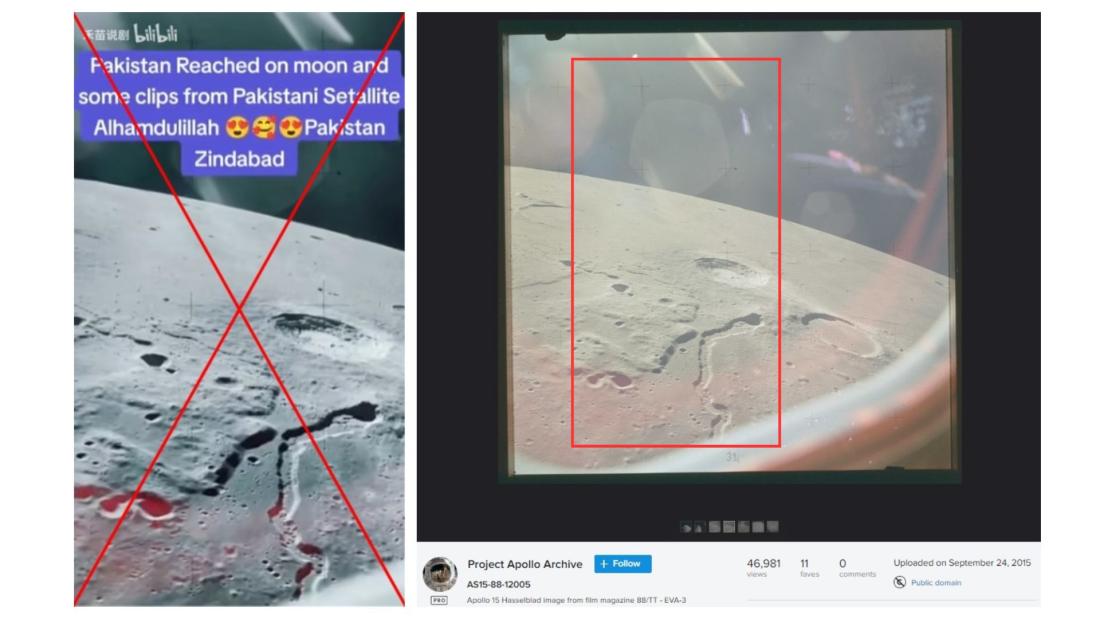
The third image in the falsely shared video was taken during the Apollo 17 mission in December 1972, its last crewed mission to the Moon (archived link).
Its caption reads: "Earth (far distant background) is seen above a large lunar boulder (foreground) on the moon."
Below is a screenshot comparison of the image used in the false video (left) and the NASA photo (right), with the corresponding portion of the photo highlighted by AFP:
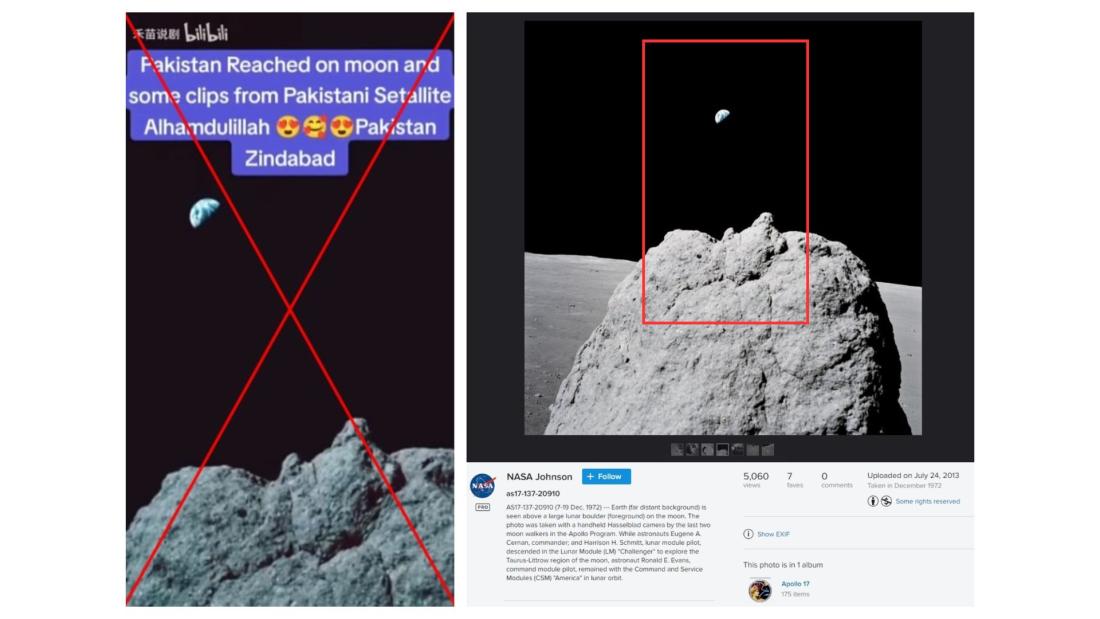
Rosetta spacecraft photo
The last image in the falsely shared video was published on the ESA's website, which says it was taken on September 30, 2016 (archived link).
It is captioned: "Rosetta's OSIRIS narrow-angle camera captured this image of Comet 67P/Churyumov-Gerasimenko at 01:20 GMT from an altitude of about 16 km above the surface during the spacecraft's final descent on 30 September."
The ESA's Rosetta spacecraft had chased the Comet 67P/Churyumov-Gerasimenko for six billion kilometres over a decade as part of a mission to demystify the Solar System's origins.
Its odyssey dramatically concluded in 2016 when it crash-landed into the comet it had orbited and probed for two years.
In its final hours, Rosetta sent home crucial last-gasp data gathered from nearer the comet than ever before, tasting the comet's gas, dust and plasma, and taking close-up pictures of the spot that became its icy tomb.
Below is a screenshot comparison of the image used in the false video (left) and the ESA photo (right), with the corresponding portion highlighted by AFP:

AFP has debunked other misinformation that has surfaced after the launch of the Chang'e-6 probe here and here.
Copyright © AFP 2017-2025. Any commercial use of this content requires a subscription. Click here to find out more.
Is there content that you would like AFP to fact-check? Get in touch.
Contact us
